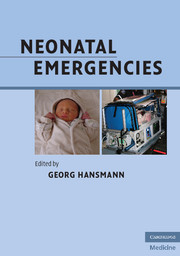Book contents
- Frontmatter
- Contents
- List of contributors
- Foreword (1)
- Foreword (2)
- Preface
- Acknowledgments
- Section 1 Organization of neonatal transport
- Section 2 Basics in cardiopulmonary resuscitation of newborn infants
- Section 3 Classic and rare scenarios in the neonatal period
- Management of healthy, term newborn infants (vaginal delivery, cesarean section, vacuum extraction, forceps delivery)
- Management of preterm and moderately depressed term newborn infants with a birth weight ≥1500 g
- Management of very preterm newborn infants (VLBW, ELBW)
- Twin–twin (feto–fetal) transfusion syndrome
- An apparently trivial call from the term baby nursery
- Out of hospital birth
- Hypoglycemia
- Meconium aspiration
- Chorioamnionitis and early-onset sepsis in the newborn infant
- Perinatal hemorrhage
- Perinatal hypoxia-ischemia
- Cerebral seizures
- Infants born to mothers on psychoactive substances
- Prenatal and postnatal arrhythmias
- Critical congenital cardiovascular defects
- Patent ductus arteriosus of the preterm infant
- Persistent pulmonary hypertension of the newborn (PPHN)
- Congenital diaphragmatic hernia
- Pneumothorax
- Congenital cystic adenomatoid malformation of the lung (CAM, CCAM)
- Chylothorax
- Hemolytic disease of the newborn
- Hydrops fetalis
- Choanal atresia
- Esophageal atresia
- Gastrointestinal obstruction
- Necrotizing enterocolitis (NEC)
- Omphalocele and gastroschisis
- Neural tube defects
- Cleft palate
- Birth trauma: brachial plexus palsy, facial nerve palsy, clavicular fracture, skull fracture, intracranial and subperiosteal hemorrhage (cephalohematoma)
- Sudden infant death syndrome (SIDS)
- Questions for review
- References (Section 3)
- Section 4 Transport
- Section 5 Appendix
- Index
- Plate section
Out of hospital birth
from Section 3 - Classic and rare scenarios in the neonatal period
Published online by Cambridge University Press: 05 March 2012
- Frontmatter
- Contents
- List of contributors
- Foreword (1)
- Foreword (2)
- Preface
- Acknowledgments
- Section 1 Organization of neonatal transport
- Section 2 Basics in cardiopulmonary resuscitation of newborn infants
- Section 3 Classic and rare scenarios in the neonatal period
- Management of healthy, term newborn infants (vaginal delivery, cesarean section, vacuum extraction, forceps delivery)
- Management of preterm and moderately depressed term newborn infants with a birth weight ≥1500 g
- Management of very preterm newborn infants (VLBW, ELBW)
- Twin–twin (feto–fetal) transfusion syndrome
- An apparently trivial call from the term baby nursery
- Out of hospital birth
- Hypoglycemia
- Meconium aspiration
- Chorioamnionitis and early-onset sepsis in the newborn infant
- Perinatal hemorrhage
- Perinatal hypoxia-ischemia
- Cerebral seizures
- Infants born to mothers on psychoactive substances
- Prenatal and postnatal arrhythmias
- Critical congenital cardiovascular defects
- Patent ductus arteriosus of the preterm infant
- Persistent pulmonary hypertension of the newborn (PPHN)
- Congenital diaphragmatic hernia
- Pneumothorax
- Congenital cystic adenomatoid malformation of the lung (CAM, CCAM)
- Chylothorax
- Hemolytic disease of the newborn
- Hydrops fetalis
- Choanal atresia
- Esophageal atresia
- Gastrointestinal obstruction
- Necrotizing enterocolitis (NEC)
- Omphalocele and gastroschisis
- Neural tube defects
- Cleft palate
- Birth trauma: brachial plexus palsy, facial nerve palsy, clavicular fracture, skull fracture, intracranial and subperiosteal hemorrhage (cephalohematoma)
- Sudden infant death syndrome (SIDS)
- Questions for review
- References (Section 3)
- Section 4 Transport
- Section 5 Appendix
- Index
- Plate section
Summary
The term “out of hospital birth” was coined in the twentieth century. Before 1900 it was the exception rather than the rule to give birth at a hospital. At this time fewer than 5% of all births took place at a hospital, increasing to almost 50% in 1940, and 99% in the 1970s. Several studies have demonstrated that planned home birth attended by appropriately qualified caregivers is safe. However, for this to be true, there should be no significant difference in morbidity and mortality when compared to standard hospital delivery. A healthy woman without contraindications (see below) has a low risk, both for herself and for the newborn infant. Midwives and/or obstetricians should discuss the advantages and possible risks of home birth with the expecting parents.
Outcome: the perinatal mortality of “intended home birth” in the USA, Canada, UK and Australia (studies from 1969 to 1996) ranges between 0.9/1000 and 5.1/1000.
Important factors influencing the mortality rate of the newborn
Underestimation of the risks associated with post-term birth
Twin pregnancy
Breech presentation
Lack of response to fetal distress
! It is important to differentiate a “planned home birth” (with the presence of a skilled attendant, e.g., midwife) from an “unplanned home birth,” which can rapidly turn into an emergency situation.
- Type
- Chapter
- Information
- Neonatal Emergencies , pp. 249 - 259Publisher: Cambridge University PressPrint publication year: 2009



